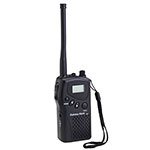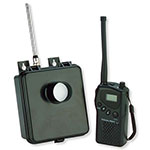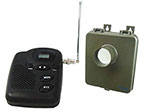 MURS Technology is a long range radio frequency with long range communication. The sender and receiver do not need line of sight and the signal can communicate across mountainous communities for a few km distance.
MURS Technology is a long range radio frequency with long range communication. The sender and receiver do not need line of sight and the signal can communicate across mountainous communities for a few km distance.
The Dakota alert products have real life ranges between ¾ km to 3 km in my testing and I only have problems if the receiver/sender is located in a deep mountainous crevasse or cave.
Best Possible Applications:
- Communities with private security who want to have guards communicate amongst each other and between homeowners while at the same time respond to sensor alerts
- Communities with a volunteer Neighborhood watch program who wish to communicate amongst each other while at the same time respond to sensor alerts
- Communities with limited entrances and exits that can be monitored
- Communities which need remote back trails monitored
Situations where MURS lack usefulness:
- Roads with too high traffic which result in too many false positives of neighborhood traffic alerting homeowners
- Communities and Owners who do not occasionally test, and maintain batteries in equipment
- Communities who naively trust their hired security to use the equipment. It is recommended that you occasionally test your security team with unannounced drills to test their response time and actions.
Here are a list of the recommended sensors:
Individual Receivers
 One MURS Hand Held Two-Way Radio
One MURS Hand Held Two-Way Radio
Part Number: M538-HT
Average Price: ~68 USD
MURS TWO-WAY BASE STATION RADIO
Part Number: M538-BS
Average Price: ~63 USD
Individual Senders/Sensors
Dakota Alert MURS Alert Transmitter
Part Number: DK, MAT
Average Price: ~108 USD
MURS Package Units
 Dakota Alert – ONE MAT AND ONE M538-HT(Sensor and Walkie Talkie)
Dakota Alert – ONE MAT AND ONE M538-HT(Sensor and Walkie Talkie)
Part Numbers: DK, MAT and M538-HT
Average Price: ~165 USD
 Dakota Alert – ONE MAT AND ONE M538-BS(Sensor and Base Station)
Dakota Alert – ONE MAT AND ONE M538-BS(Sensor and Base Station)
Part Numbers: DK, MAT and M538-BS
Average Price: ~171 USD
Additional Accessories
Sensor Birdhouse Unassembled Kit (protection)
Part Numbers: DK-BH-1-UF
Average Price: ~16 USD
Dakota Alert also sells regular, non MURS, equipment that is less expensive but doesn’t have the same range as the products listed above and only intended for use around the perimeter of your home.
You can add any amount of sensors or receivers together and have essentially any combination of base stations, walkie talkies, and sensors communicating with each other in a community. This means that every household doesn’t need to buy their own sensors and the whole community can share the remotely located sensors as long as they have either a base station or walkie talkie tuned to the right channel.
The Sensors use 6 AA batteries that last for a few months before needing to be replaced. The Sensors shoot a single invisible beam that typically detect the width of a road and have the sensitivity to detect large animals, humans or cars with little false positives. The exception to this is if you place the sensor in a poor location (I.E. under a balsa wood tree) where large leaves are continuously falling inches away from the sensor giving many false alerts. The sensors are best mounted 3-4 feet off the ground and can be camouflaged. The sensor is a single unit that doesn’t need another part on the opposite end of the road.
Fundamental Differences between base station and receiver:
Base Station Advantages – No battery replacement(plug in transformer), External siren output alert
Base Station Disadvantages – Not Portable, Cannot use as a Walkie Talkie
Walkie Talkie Advantages – Portable, Can both receive alert messages and simultaneously use to speak to other MURS walkie talkies
Walkie Talkie Disadvantages – Need to replace or recharge 6 AA batteries, Doesn’t have external siren optional output
Reliability and Warranty- These products come with a 1 year warranty from Dakota Alert and the company has a history of good service replacing units quickly. I have seen sensors in Costa Rica last typically between 9 months to a couple years. The reliability is a combination of many factors but it is important to keep the moisture and humidity down. This can be accomplished sometimes by placing an enclosure of roof around the sensor or oter times it is better to have more direct sunlight to reduce humidity. Using replaceable Silica Gel Desiccant packs is another trick to extend the life of the sensor.
Additional Information- Although there are 190 possible channels to tune these units to the sensors only send out 4 possible call tone alerts to set which audibly speak “Zone 1”, “Zone 2”, “Zone 3”, “Zone 4”. You can set multiple sensors to alert to a single zone but ultimately you only are identifying 4 different possible types of alerts.






